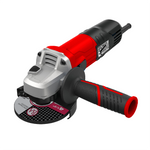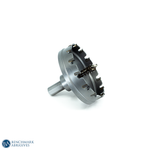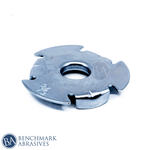
How To Clean Stainless Steel After Welding

Many amateur welders and experts working with stainless steel know that the metal takes on a tint during the heating and welding process. This may detract from the end project's aesthetic appeal and make it unprofessional.
After casting, you can clean stainless steel using a variety of methods. Rust removal from stainless steel often involves mechanical, chemical, and electrochemical methods. These are the most practical and straightforward approaches. Hopefully, you will be fully informed, if you read the entire article.
Cleaning Stainless Steel After Welding: 4 Simple Techniques
After welding, stainless steel needs to be cleaned. A beautiful appearance on the steel's surface is vital. Until recently, the only mechanical and chemical techniques for washing stainless steel were Recently, electropolishing was added to it. Below, we've listed four techniques for cleaning stainless steel after welding.
1. Mechanical Process
Mechanical welding cleaning is inexpensive. For small tasks, mechanical techniques are typically quite helpful. The rust deposit on the stainless steel surface can be easily removed using these procedures. Use the method listed below to clean stainless steel.
Grinding The Weld
After welding, the remaining rust on the stainless steel needs to be removed. For this, a grinder is required. Rust shouldn't be more challenging to cut than stainless steel.
-
Things To Remember
Three things need to be done in this step, so keep that in mind while you grind. First, roughen the stainless steel surface to make the rust easier to remove. Second, a grinding machine should be used to grind rust welding. Utilizing lubricants to stop corrosion is the third. It is used to get a beautiful polish on the stainless steel surface.
Utilize The Grit Blasting Method
The welds on the steel surface are simple to clean, thanks to the grit blasting method. By forcing air at high pressure through the nozzle, grit blasting is accomplished. The rust is removed when high-pressure air falls suddenly on the welding.
2. Chemical Process
A chemical can quickly and effectively remove welding's harsh marks and subsequent rust. Avesta Cleanser, a kind of phosphoric acid, is used in this chemical process. You can use it to create a luxurious stainless steel surface.
Remember that paint, grease, and other substances should not be on the workpiece's surface. Sprays of chemicals are used to coat the surface. After using Cleanser, be sure to wash the area.
Here is a description of the chemical reaction.
Pickling Process
Pickling is a method of preserving food with sulfuric or hydrochloric acid. Steel flakes are dissolved in this. This pickling spray is used to treat the stainless steel after welding. The acid you use will determine how well pickling works.
Keep an eye on the pickling temperature because the acid reacts more quickly at higher temperatures. You can use three pickling methods to clean stainless steel. The pickling procedure is described below.
A. Using A Pickling Bath
If you have the appropriate tools, submerge the workpiece in a pickling bath. There is a minor issue if the workpiece is enormous. You should keep the pickling bath at 25 to 65 degrees centigrade. Heat workpieces should not be pickled for too long. The steel surface will become rough, which cannot be fixed.
B. Using A Pickling Paste
Binding agents and acidic acid are combined in this paste. Only the area where the stainless steel is welded is coated with this paste. An acid-resistant brush should then be used to scrub the area. Following that, water should be applied to clean the area thoroughly. This paste dries up and loses effectiveness, which is a significant issue. The paste might not work if it is below 30 degrees.
C. Using Pickling Solution
Both nitric acid and hydrofluoric acid are present in this mixture. While welding rust, this acid produces oxidation. This softens the welding. Remove your stainless steel and gently rinse it in water once it has cooled. This pickling solution can easily remove rust welding from large surfaces.
3. Electrochemical Process
In my opinion, cleaning stainless steel after welding is the most accessible process by the electrochemical process. The two techniques mentioned above come with health hazards. Even if the health risk is minimal, this procedure is safe.
These electrochemical procedures simplify removing rust, cross-contamination, and other impurities in your stainless steel. With this technique, a functional emphasis can be achieved relatively rapidly. The steps are explained below.
-
First, the stainless steel portion of the welding is submerged in the electrolytic solution.
-
The solution then starts to flow with electricity. Due to oxidation, various impurities, rust, and tough stains are eliminated from the steel.
-
It is challenging to fully submerge stainless steel with a significantly welded portion. A brush with electricity flowing through it is used to address this issue. By doing this, the steel's surface is made rust-free.
4. Cleaning With Electrolytic Weld
A conductive joint cleaning brush is used for this technique. This technique is quick and easy. Using a brush, the welding cleaning solution is applied to the workpiece. Electric current (AC/DC) is present concurrently. Welding is now simplified. Below is a discussion of a few of its unique features.
-
You do not need to clean your welded steel if it is significant. You can transport the cleaning brush there.
-
The rust on stainless steel can only be removed using pickling paste and this conductive joint cleaning brush. There are no additional steps.
-
Only the steel areas where welding has been done need to be cleaned. You become more focused and precise as a result.
If these techniques are used to clean the welding, any contaminants in the steel can be avoided. Additionally, this technique stops the corrosion of the steel's surface.
Place Where Rust Enters
Stainless steel has a rougher surface structure at the annealing colors, making it more corrosive. To put it another way, stainless steel, which is supposed to be rust-resistant, may begin to rust when the passive coating has been removed. Additionally, the annealed colors' roughened surfaces serve as the perfect breeding grounds for germs. This is especially problematic for applications where the highest levels of hygiene are required, like in the healthcare or food processing industries.
What Technique Is Best For Cleaning Welds?
In essence, each of the three approaches has the following advantages:
-
Some automated production procedures make sense for chemical weld cleaning or pickling. This method has the drawback that the pickle is expensive and harmful to humans and the environment.
-
The inexpensive cost of purchasing stainless steel brushes or cloths is a benefit of mechanical weld cleaning. The drawbacks include that it takes time and isn't always reliable.
-
Even outside of structures, electrochemical cleaning of stainless-steel welds is quick, simple, and thorough. Passivation and the annealing colors are removed in the same work phase. However, you must have the appropriate weld cleaning tool on hand.
Crucial Points to Remember
-
Safety: it is the first and foremost thing to remember. Be sure to wear safety gear when working with abrasives or chemicals. Safety gears include gloves, respirators, face shields, masks, etc.
-
Work in a ventilated area: ensure to work in a ventilated area when working with chemicals or dust. This helps with regular airflow and minimizes health risks.
-
Passivation: It refers to the process of treating stainless steel by dipping it into chemicals to form a thin layer of protective coating that enhances its corrosion resistance. After cleaning the stainless steel surface, restore the protective oxide layer on the surface to prevent rust.
CONCLUSION
The correct processes can be quickly followed when cleaning stainless steel after welding. In addition to cleaning, stainless steel also has to be polished. This steel's hardness, longevity, and gloss are its primary characteristics. The most acceptable methods, in my opinion, for keeping stainless steel's spotless surface and brilliant shine are electrochemical ones.



































































